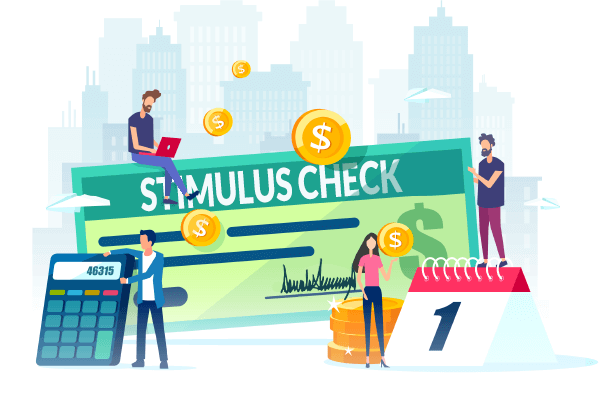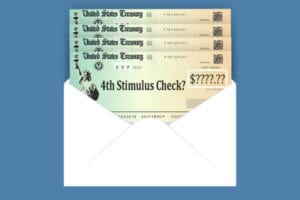Stimulus Checks for COVID-19 Relief
The phrase “stimulus check” is second only to “coronavirus” or “COVID-19” as something to talk about these days and people are definitely talking.
About 159 million Americans have received the $1,200 check promised by the federal government, but millions more are still waiting to get stimulated.
The IRS estimated that another 30-35 million consumers are still due their slice of coronavirus assistance from the $2.2 trillion CARES Act that passed on March 27. Those who are still waiting on their checks will not be pleased to know that, according to the Government Accountability Office, a glitch in the legislation led to over 1 million checks totaling $1.4 billion being issued to dead people.
If you received a signed letter from President Donald Trump detailing the payment but have not received the money, that’s a sign that there is a holdup. Those letters were supposed to be sent two weeks after the payments.
The deadline to update your direct deposit information using the IRS Get My Payment Tool expired on May 13. Since then, the IRS began mailing out paper checks. Many received the stimulus check in early May, alongside their usual monthly benefit payment for Social Security, disability benefits (SSDI), Railroad Retirement Benefits, Supplemental Social Security (SSi) and VA.
How to Track the Status of Your Stimulus Check
The IRS has created a Get My Payment portal so you can learn the status of your payment. It provides updates on whether the IRS is processing your check or has already scheduled your payment; whether your payment will be made by a paper check, prepaid debit card or through direct deposit to your bank account; and whether there are problems holding up your payment.
To use this portal, you must input your Social Security number or Individual Taxpayer Identification Number along with your date of birth, street address and postal code. The IRS updates its status tracking information daily. You should get a letter about 15 days after the IRS issues your payment telling you how much you received and how you received it.
After using the IRS tracker, you may sign up for a free service from the post office that tells you exactly when your stimulus check will arrive in the mail.
Why Haven’t I Received My Stimulus Check?
There are several reasons why your check hasn’t shown up. This is the federal government we’re talking about.
- Your payment has been scheduled for later in the year. The IRS is sending checks to those with lowest incomes first.
- The IRS began processing your paper check before you submitted your direct deposit information. If that happens, you’ll get it in the mail.
- The banking information the IRS has for you is out of date or no longer valid. The IRS uses banking information from your 2018 or 2019 tax return to send your payment. If your tax preparer set up a temporary account, such as a prepaid debit card to receive your returns, the agency will reprocess the stimulus check by mail.
- The IRS was waiting for your banking info before sending your check. If you didn’t sign up for direct deposit by May 13, IRS began sending paper checks and debit cards to those for whom it lacked banking information.
- Your bank had trouble processing the direct deposit.
- A claimed dependent is not eligible for a payment. Parents who are not married to each other and do not file a joint return cannot claim a qualifying child as a dependent. Only the parent who claimed their child on their tax return may receive the payment. Dependent college students do not qualify for a payment.
- If you are behind on child support, the IRS said your payment may be reduced or completely deducted.
- You may have been scammed. If you receive a letter from the IRS indicating the agency has already sent your money and the payment hasn’t arrived, you need to report that. The letter tells you how.
Eligibility for the COVID-19 Stimulus Check
Every individual making $75,000 or less will receive a check for $1,200. Couples making less than $150,000 and that file taxes jointly should each receive $1,200 for a total of $2,400, with an additional $500 for each child. Those making between $75,000 and $99,000 a year ($198,000 jointly) should receive reduced checks on a sliding scale. Those making more than $99,000 individually or $198,000 jointly are ineligible.
Eligibility is being determined by 2019 and 2018 tax returns, but for those that are not required to file taxes, the IRS has set up a separate tool. Follow the link in these instructions for non-filers. The government will verify your income for those years and, if you qualify and have a bank account registered for tax refunds, you should receive a direct deposit. If you don’t have a bank account registered with the IRS for direct deposits, you should receive a stimulus check in the mail.
What Does Payment Status Unavailable Mean?
- The IRS has not processed your 2019 tax return
- The application doesn’t have your bank data and the IRS is working to add it
- You don’t usually file a tax return
- You used the Non-Filers section of the website and your entry hasn’t been processed yet
- You receive SSI or VA benefits and don’t file a tax return
- You’re not eligible for a payment (see Eligibility)
The information on the Get My Payment portal is updated once per day, overnight so there is no need to check more often than that.
How to Report a Missing Stimulus Check to the IRS
You may still have questions, especially if you haven’t received a check, or you get the dreaded “payment status unavailable” notice. To report missing checks or ask other questions, call the IRS at 800-919-9835.
The IRS added 3,500 telephone representatives in May, but don’t be surprised if you don’t get through immediately. A lot of people have questions. You can go online to find answers to frequently asked questions about Economic Impact Payments and the Get My Payment tool.
One question a lot of people have is whether the stimulus money will affect their 2020 taxes. It won’t. It is not considered taxable income, so it won’t increase what you owe or reduce your refund when you file next year.
Another question the IRS can’t answer: Is a second stimulus check on the way? Possibly. Senate Republicans rejected the plan passed by House Democrats but have said they are drawing up a plan of their own, perhaps to be finished in late July. Stay tuned.
Sources:
- N.A. (ND) Get My Payment Frequently Asked Questions. Retrieved from https://www.irs.gov/coronavirus/get-my-payment-frequently-asked-questions#paymentnot
- Konish, L. (2020, June 8) 35 million stimulus checks are still outstanding. What you need to know if you’re waiting for your money. Retrieved from https://www.cnbc.com/2020/06/08/35-million-stimulus-checks-havent-been-sent-out-who-is-waiting-for-money.html


















